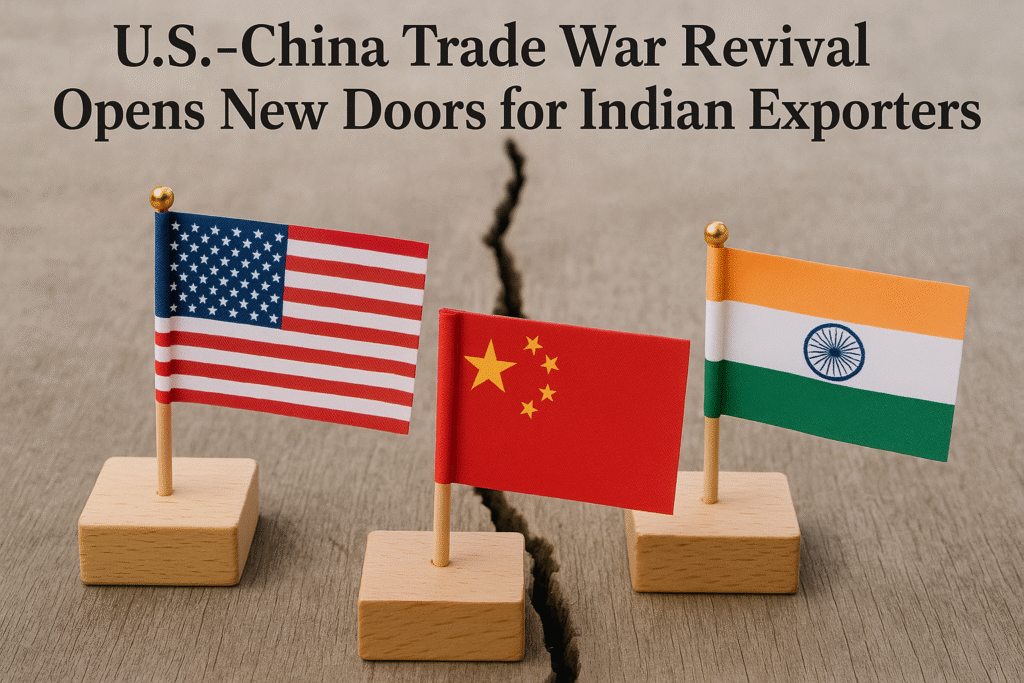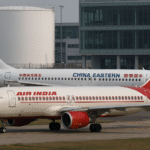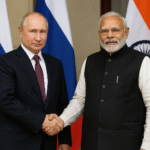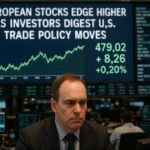By Harshit | October 11, 2025 | New Delhi, India
The renewed trade conflict between the United States and China could deliver a major boost to Indian exporters, as soaring tariffs on Chinese goods push American buyers to seek alternative suppliers. With U.S. President Donald Trump announcing a sweeping 100% tariff on Chinese exports, Indian manufacturers in sectors such as textiles, toys, and electronics are preparing to seize a rapidly expanding market opportunity.
India exported goods worth USD 86 billion to the U.S. in 2024–25, maintaining its position as Washington’s largest trading partner in South Asia. According to trade experts, the new wave of tariffs will make Chinese products significantly costlier in the American market, providing India with a long-awaited competitive edge.
Indian Exporters Eye Opportunity
Federation of Indian Export Organisations (FIEO) President S.C. Ralhan expressed optimism, noting that India is poised to capture new business from the ongoing trade rift. “We may gain from this escalation,” Ralhan said, suggesting that increased tariffs will encourage American companies to source more goods from India.
Several exporters have already reported heightened inquiries from U.S. retailers and importers. “This 100% additional tariff on Chinese goods gives us an upper edge,” said a textile exporter quoted by PTI. “These higher customs duties create huge export opportunities for India to America.”
Toy exporter Manu Gupta echoed the sentiment, saying, “High duties will create parity and give us a level playing field.” He added that major U.S. retailers like Target have begun reaching out to Indian suppliers for new product lines.
Rising Prices, Global Ripple Effects
Trade think tank Global Trade Research Initiative (GTRI) observed that the escalating tensions will push up global prices of electric vehicles, wind turbines, and semiconductor components, as both nations target each other’s high-tech sectors.
While the U.S. currently levies 50% tariffs on Indian goods, compared to 30% on Chinese imports before the new hikes, experts believe the recent policy shift levels the playing field. “Indian exporters can now compete more effectively in high-volume, price-sensitive segments,” said a senior economist at GTRI.
However, sustaining these gains will depend on India’s ability to scale production capacity, meet strict U.S. quality standards, and align with compliance norms. The opportunity, analysts say, could be fleeting if exporters fail to deliver consistent quality or competitive pricing.
India’s Expanding Trade Ties with the U.S.
The United States remained India’s largest trading partner in FY 2024–25, with bilateral trade valued at USD 131.84 billion. U.S. imports from India accounted for nearly 18% of India’s total exports and 10.73% of total merchandise trade.
Ongoing negotiations for a bilateral trade agreement between the two nations could further consolidate India’s role as a preferred alternative to China for American buyers, particularly in sectors such as consumer goods, electronics, and renewable energy components.
Trump Revives Tariffs, Escalates Trade Tensions
President Donald Trump reignited the long-dormant trade war on Friday, imposing a 100% tariff on all Chinese goods entering the U.S. and introducing new export controls on what he called “critical software.” The restrictions take effect on November 1, 2025, just days before existing tariff relief was scheduled to expire.
The decision came in response to China’s October 9 export curbs on rare earth minerals, which are vital for U.S. defense, electric vehicle, and clean-energy industries. “It was shocking,” Trump said during a press briefing. “I thought it was very, very bad.” He described Beijing’s move as a “hostile order,” adding, “For every element they have monopolized, we have two.”
The escalation also cast doubt on a planned meeting between Trump and Chinese President Xi Jinping in South Korea, with Trump saying on social media that there now seemed “no reason” to proceed. He later softened his stance, saying, “I haven’t canceled. I would assume we might have it.”
The Road Ahead
For India, the renewed trade hostilities between the world’s two largest economies present a strategic opening. Yet experts caution that success will hinge on India’s long-term trade reforms, investment in infrastructure and logistics, and the ability to sustain supply chains at scale.
As the U.S.-China trade rift deepens, Indian exporters may find themselves at the center of a historic realignment in global commerce — one that could redefine the balance of manufacturing power for the next decade.







